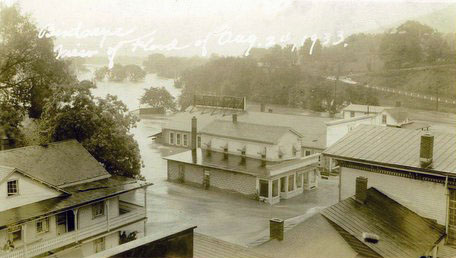
1933 flood, Margaretville, Bridge Street
It has been painful to watch the tragedy of Irene unfold – lives lost, people uprooted, businesses stopped in their tracks, buildings rearranged. Our hearts are with all of those whose lives have been profoundly changed. This is what it means to live in this stream-crossed region – once in awhile, you pay.
It’s strangely reassuring to know that flooding – and mucking the East Branch out of one’s home or business — is a common experience among those who have called the Catskills home. Consider the Flood of October 9, 1903, as recounted in the Catskill Mountain News the following week:
“The water has since flowed across Mr. Gorsch’s back lot and emptied itself into the lower end of Swart Street. The rising water in the river drove Mr. and Mr. George H. Hewitt from their home near the river bridge and carried off a lot of their vegetables and other belongings. In exchange, however, tt left them a lot of good stovewood “in the log” right in their dooryard. . .
“Dickson’s livery was flooded and the horses and carriages were taken over to the Ackerly barn. The water rose high enough to run out of the dining-room window at the Hotel Bouton and soaked everythlng on the first floor of the house. It got Into Hubbell’s grocery store. The basement of Searle’s hardware store was awash and there was good boating in “Andy ” Easman’s cellar. Sperling’s bakery, adjoining, came in for a soaking and the supply of fresh broad and hot rolls was temporarily shut off.
“The water overflowed upper Main street and there was a good-sized lake in front of the residences of E. Laidlaw and E. L. O’Connor (Ed: today’s Legion hall). Houses in that part of the village lying above the bridge over the Binneklll near the foundry were flooded and the occupants were held prisoners. . . .
“Morgan Olmstead and Dr. Chamberlain, while on their way from Highrnount to Griffin C rners were obliged to ford the Emory Brook this side of that place, the rains of the past few clays having raised the stream until it was a perfect torrent. The wagon was overturned and the occupants tossed into the flood, Morgan succeeded in climbing onto the horse’s back, but the wagon was pitched by the angry waters on top of horse and rider, knocking him into the stream again, which was last seen of him. Dr. Chamberlin grasped the reins and was dragged by the horse to the shore in an unconscious condition and quite badly injured. The remains of the unfortunate young man were found by Albert Hitt early Saturday morning lodged In the willows near the grand stand on the Fleichmanns ball ground. The funeral occurred on Monday.”
